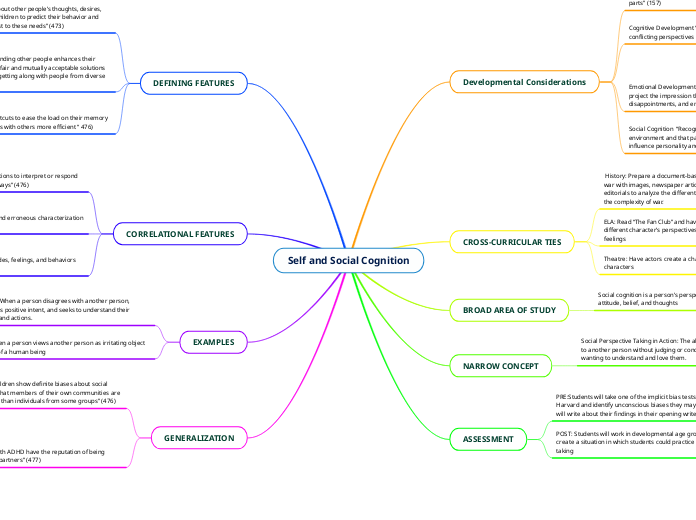Self and Social Cognition
Developmental Considerations
Physical Development: “By this age level many young people have shed the gawky appearance of young adolescence, now presenting as attractive young adults, comfortable in their own skin and balanced in the relative sizes of their separate body parts” (157)
Many young people take care of their bodies and act as though they are comfortable with their physical appearance; however, a survey in the UK indicated that “young people aged 13–19, 35% said their body image causes them to ‘often’ or ‘always’ worry”
Cognitive Development “Willingness to critically evaluate conflicting perspectives on an issue (in some students) (261)
Some students are willing to listen to other people’s opinions on an issue and think critically about why they feel that way.
Emotional Development “Some adolescents (boys especially) project the impression that they are not bothered by losses, disappointments, and embarrassments” (435)
As some adolescents act as though they’re not hurt or embarrassed by an experience, it’s important to teach them how to honestly express their feelings and think critically about why they’re feeling that way. As they talk about their feelings honestly and discover the root of those feelings, they will become free.
Social Cognition “Recognition that people are products of their environment and that past events, and present circumstances influence personality and behavior” (475)
Understanding that people learn to act in certain ways because of their home environment, the way they were raised, and their life experiences.
CROSS-CURRICULAR TIES
History: Prepare a document-based inquiry of the Viet Nam war with images, newspaper articles, poems, short stories, and editorials to analyze the different perspectives and learn about the complexity of war.
ELA: Read “The Fan Club” and have students portray the different character’s perspectives, values, thoughts, and feelings
Theatre: Have actors create a character analysis of their characters
BROAD AREA OF STUDY
Social cognition is a person’s perspective of another person’s attitude, belief, and thoughts
NARROW CONCEPT
Social Perspective Taking in Action: The ability to see and listen to another person without judging or condemning, but only wanting to understand and love them.
ASSESSMENT
PRE:Students will take one of the implicit bias tests from Harvard and identify unconscious biases they may have. They will write about their findings in their opening write.
POST: Students will work in developmental age groups to create a situation in which students could practice perspective-taking
DEFINING FEATURES
”Drawing inferences about other people’s thoughts, desires, and intentions allows children to predict their behavior and determine how to adjust to these needs” (473)
When we draw inferences, we use evidence to make educated guesses; we can teach our students to use look closely at a person’s body language, words, background, values,and actions to make accurate inferences
“Adeptness in understanding other people enhances their proficiencies in finding fair and mutually acceptable solutions during conflicts and in getting along with people from diverse cultures”(473)
As we learn to accurately perceive other’s perspectives, we see things as they really are. People long to be understood and when they are understood, they’re more open to discuss possible solutions. When both parties feel understood, a win-win solution becomes a possibility
“People often take shortcuts to ease the load on their memory and make their dealings with others more efficient “ 476)
When we make unwarranted assumptions about ourselves or another person, those assumptions are often incorrect. Efficiency often does not equal accuracy
CORRELATIONAL FEATURES
Social-Cognitive Bias “Predispositions to interpret or respond to social situations in particular ways” (476)
After taking the Harvard tests, I learned about some of my unconscious biases. After becoming aware of these biases, I have caught myself responding in a particular way and changed my perspective.
Stereotypes “a rigid, simplistic, and erroneous characterization of a particular group”
I had a close family member who stereotyped Latter-day Saints and this impacted the way I and my siblings viewed them as we were growing up
Prejudice “Exhibit negative attitudes, feelings, and behaviors toward a group"
It’s important to do a personal inventory of the way we view societal groups and consider how this impacts the way we treat individuals
EXAMPLES
Positive: When a person disagrees with another person, presumes positive intent, and seeks to understand their feelings and actions.
When we see the person as an individual, a child of God who has unique gifts, values, and experiences, we can feel the love Heavenly Father has for them.
Non: When a person views another person as irritating object instead of a human being
When we view them as an irritation or object, we tend to judge them and have unkind thoughts about them.
GENERALIZATION
Over: “By age 4, children show definite biases about social groups, expecting that members of their own communities are better in some way than individuals from some groups” (476)
For example, some people believe that all Latter-day Saints are better in some ways than members of other religions
Under: “Children with ADHD have the reputation of being undesirable social partners” (477)
Children with ADHD could be further categorized to create a more accurate picture of why some might struggle making friends. Some might “find it difficult to take the perspective of other people because of impaired brain circuits for social reasoning, andsome might have disruptive behaviors.
